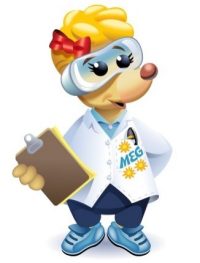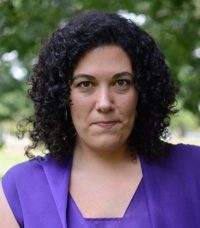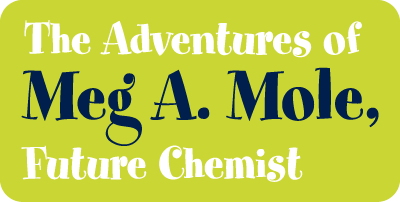
In honor of this year’s National Chemistry Week theme, “Sticking with Chemistry,” I traveled to the School of Materials Engineering at Purdue University in West Lafayette, Indiana. Here I met Dr. Chelsea Davis, a chemist who studies adhesives and glues. A materials chemist who studies adhesives is also known as a polymer chemist. I know a lot of my friends use glue in their school projects, so I could not wait to learn more about the chemistry behind Dr. Davis’ work!
“So, what does a materials chemist do?” I asked Dr. Davis. She replied, “I measure how sticky surfaces are. I try to understand why some surfaces are stickier than others. I have a fancy microscope that uses lasers to see colors in 3D. I use wrinkles and cracks to change how sticky rubber surfaces are. I build my own machines to measure adhesion.”
Personal Profile – Dr. Chelsea Davis

- Birthday? August 23
- Favorite food? Dr. Davis is obsessed with chickpeas!
- Favorite pastime/hobby? Crocheting huge blankets
- What kind of interesting projects are you working with now? One of my students is working on a project to invent a new type of sticky surface that changes its stickiness depending on how you attach it to surfaces. She built her own adhesion tester, and is getting some really cool results now.
Dr. Davis brought me into her laboratory and continued to tell me more about her work. She explained, “Most of my experiments are really little. It is normal for many of my samples to fit on the tip of your finger. When people come into my lab, they normally see me with my head really close to my work, wearing a jeweler’s visor that helps me see little things. The visor makes my eyes look really big and my students laugh when they see me in them.” I did laugh when she put the visor on for me! It was very neat to see how something so small could be so helpful in the world.
I really enjoyed my time visiting with students in in Dr. Davis’ lab, but she explained that she does most of her work in her office. She explained, “I have several students who work with me on research. We meet together in my office, and then they spend most of their time doing the experiments in the lab. I miss working on experiments myself — but this way, I get to think about many different research projects at the same time. My students bring me new data all the time, and I get to work with them to figure out what it means.”
Dr. Davis told me more about a project she was working on for the roads in Indiana. I was a bit confused about which adhesives would be needed for roads, so she told me about it in more detail. She said, “I designed a new way to test how strong the adhesion was for temporary pavement marking tapes. These are the tapes that road construction workers use to mark traffic lines when they are making new roads. It’s important that these tapes are really sticky in different conditions. Sometimes they aren’t as sticky when they get cold or wet. Since I live in Indiana, this is really important here as well.” Lines on the road are very important for everyone.
Growing up, Dr. Davis really enjoyed math and Spanish, but told me about an experiment she did as a child that she still uses in her classroom as a demonstration today. “I remember making slime with Elmer’s Glue and borax in elementary school. That was my first memory of a science experiment,” she said. It wasn’t until high school that she realized she wanted to be a scientist. She said, “One day when I was about 16 years old, a scientist came to our chemistry class to teach us about polymers. She held up a bowling ball and said, ‘This is one molecule.’ From that moment on, I was hooked. I attended science camp at her college that summer and haven’t stopped learning about science ever since.”
I asked Dr. Davis what she liked the most about her job. “I love watching the expression on my students’ faces the first time that an experiment really works. Their excitement is contagious and makes me want to do more.” I cannot wait to see what Dr. Davis does next!


